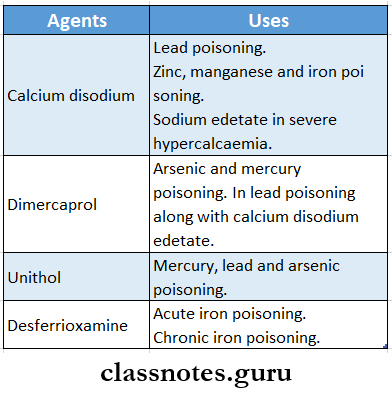Miscellaneous Important Notes
1. Chelating Agents

Pharmacology essay questions
2. Astringents
- They are substances that precipitate proteins
- Affects only the superficial layer
- Toughen surface making it mechanically stronger
- Decreases exudation
- Used in the treatment of
- Bleeding gums
- Bleeding piles
- Alkaloidal poisoning
Read And Learn More: Pharmacology Question and Answers
Miscellaneous Long Essays
Question 1. Define and classify antiseptics. Write in detail about the mechanism of action, different preparations, and uses of phenol.
Answer:
Definition:
- Antiseptic is an agent that destroys micro-organisms on contact and can be used on living tissues
Classification:

Phenol:
Mechanism of Action:
- It acts by following mechanisms
- Oxidation of bacterial protoplasm
- Denaturation of bacterial proteins including enzymes
- Detergent-like action increases the permeability of the bacterial membrane
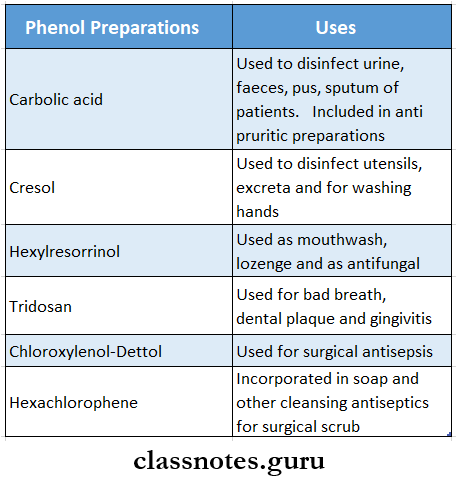
Miscellaneous Short Essays
Question 1. Acriflavine
Answer:
- Acriflavine is an orange-yellow acridine dye
- It is active against gram-positive bacteria and gonococci
- It is non-irritant
- Solutions lose efficacy on exposure to light, so it is stored in amber bottles
- It does not retard the healing
Uses:
- 1:1000 solution is used in infected wounds
- 2% is used in vaginitis and cervicitis
- Bandage impregnated with acriflavine- vaseline is used in burn dressing
Question 2. Chlorhexidine
Answer:
- Chlorhexidine is a powerful nonirritating antiseptic that disrupts the bacterial cell membrane
- It causes the denaturation of intracellular proteins
- It is more active against gram-positive bacteria
Uses:
- As an antiseptic in dentistry
- As oral rinse or toothpaste
- In acute necrotizing gingivitis
- Before periodontal surgery to prevent infections
- Daily use reduces oral infections in immunocompromised patients
Disadvantages:
- Brownish discoloration of teeth
- Unpleasant after taste
- Alteration of taste
- Occasionally oral ulceration
Question 3. Potassium permanganate
Answer:
- Potassium permanganate is an oxidizing agent
Properties:
- Occurs as purple crystals
- Highly water soluble
- Liberates oxygen which oxidizes bacterial protoplasm
- Has germicidal capacity
Uses:
- Used for gargling, douching
- Irrigating cavities,-urethra, and wounds
- Used to disinfect water
- Used for stomach wash in alkaloidal poisoning
Adverse Effects:
- High concentration causes burns and blistering
- Promote rusting of surgical instruments
Pharmacology short questions and answers
Question 4. Uses of Antiseptics in Dentistry
Answer:
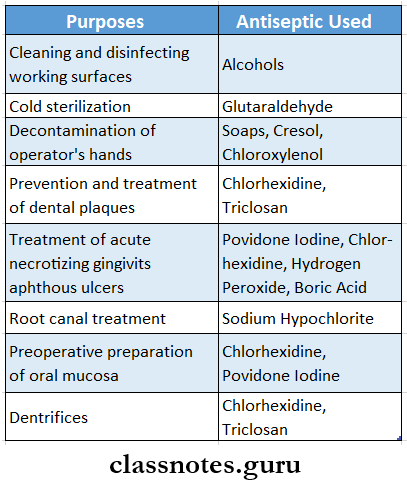
Question 5. Bleaching agents
Answer:
- Bleaching agents are agents used to remove stains from teeth or to improve their whiteness.
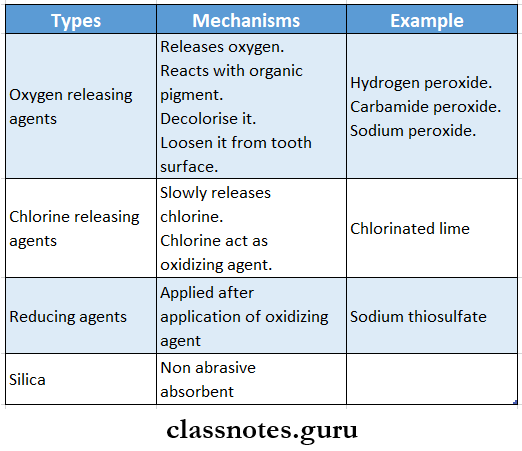
Question 6. Commonly used antiseptics
Answer:
Classification:
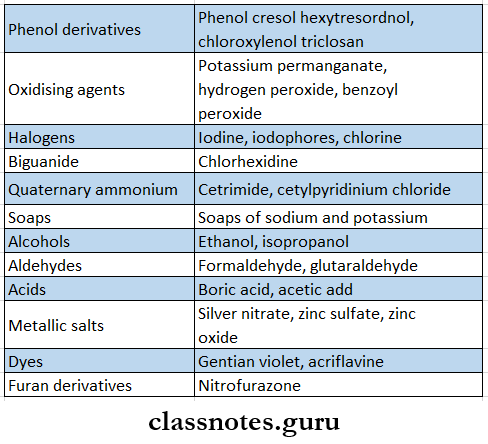
Question 7. Chelating agents
(or)
Define chelation. Mention four chelating agents
Answer:
- Chelating agents bind the heavy metal ions and make them nontoxic, the chemical complex formed is called a chelate
- The process of complex formation is called chelation.
Chelating Agents:
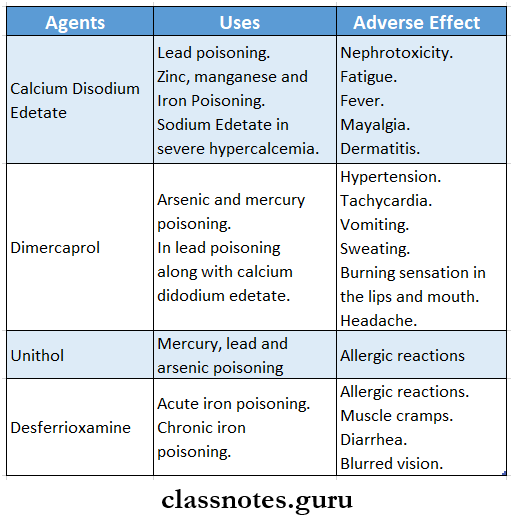
Miscellaneous pharmacology questions
Question 8. Dimercaprol
Answer:
- Dimercaprol is a colorless, oily liquid
- Developed by the British during World War II as an antidote to lewisite
- Hence it is known as British Anti-lewisite or BAL
- Dimercaprol chelates arsenic, mercury, lead, and other heavy metals
Uses:
- Arsenic and mercury poisoning
- In lead poisoning along with calcium Disodium edetate
Adverse Effects:
- Hypertension
- Tachycardia
- Vomiting
- Sweating
- Burning sensation in the lips and mouth
- Headache
Question 9. EDTA
Answer:
- The calcium sodium and Disodium salts of EDTA form stable and highly water-soluble complexes with many
- divalent and trivalent metallic ions
- It chelates metals like zinc, manganese, iron, and lead deposits in the bone which are then mobilized, chelated, and excreted through the kidneys
Uses:
- Lead poisoning
- Zinc, manganese, and iron poisoning
- Sbdium edetate in severe hypercalcemia
Adverse Effects:
- Nephrotoxicity
- Fatigue
- Fever
- Myalgia
- Dermatitis
Question 10. Thiamin deficiency
Answer:
- Deficiency of Thiamine results in beri beri
Symptoms:
- Loss of appetite
- Weakness
- Constipation
- Nausea
- Mental depression
- Peripheral neuropathy
- Irritability
- Numbness in the legs
Types:
1. Wet Beri Beri
- Characterized by edema of legs, face, trunk, and serous cavities
2. Dry beri beri
- Associated with neurological manifestations
3. Infantile Beri Beri
- Seen in infants
Question 11. Ascorbic add deficiency
Answer:
Deficiency Manifestations:
- A deficiency of vitamin C leads to scurvy
Features of Scurvy:
- Spongy and sore gums
- Loose teeth
- Anemia
- Swollen joints
- Fragile blood vessels
- Decreased immunocompetence
- Delayed wound healing
- Impaired hormonal functions of the adrenal cortex and gonads
- Hemorrhage
- Osteoporosis
Question 12. Name two fat-soluble vitamins arid mention two uses of them
Answer:
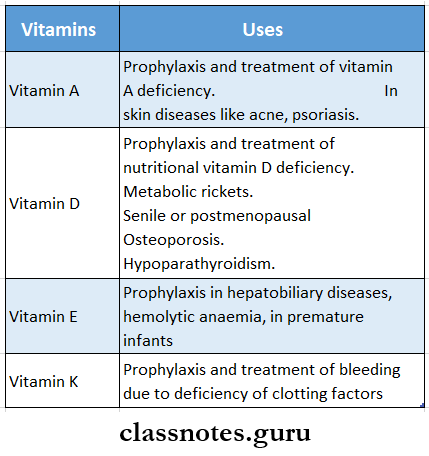
Pharmacology long essay questions
Question 13. What procedure will be adapted so that tenants do not result from your treatment? How will you treat a case of tetanus?
Answer:
Prevention of Tetanus:
- Pregnant women can be administered two tetanus toxoid injections, 1 ml IM in the third trimester of pregnancy
- Immunized individuals can be given booster doses to achieve active immunity
- Tetanus antitoxin can be used for penetrating wounds of the head and face and wounds of devitalized tissues
Treatment of Tetanus:
1. General management
- Admission and isolation in a quiet room, to avoid minor stimuli which precipitate spasms
- Wound care includes drainage of pus, excision of necrosed tissue, removal of foreign body, and proper dressing
- Inj. Tetanus toxoid 0.5 ml IM
- Antitetanus serum, ATS – 50000 units IV or
- Human Antitetanus globulin – 3000-4000 units
- Inj. crystalline penicillin 10 lakh units every 6 hourly for 7-10 days
2. Specific management
- Mild cases
- Sedatives- combination of chlorpromazine, phe- nobarbitone and diazepam
- Seriously ill cases
- Use of nasogastric tube for feeding purposes and for administration of drugs
- Dangerously ill cases
- Sedatives
- Muscle relaxants
- Positive pressure ventilation
- Adequate nutrition
- Care of urinary bladder, bowel
- Frequent change of position to avoid bed sores
Question 14. Uses of astringents in dental practice.
Answer:
- Astringents are substances that precipitate superficial proteins without penetrating the cells when applied to the skin or mucous membrane
- They form a protective coating and harden the surface
Actions:
- Check minor hemorrhages
- Arrest capillary oozing
- Promote clotting
- Precipitate protein on the bleeding surfaces.
Uses:
- As obtundents
- As styptics
- As mummifying agent
- Mouthwashes
- Paints
- Lotion and denitrifies in aphthous ulcers, stomatitis, and gingivitis
Types:
- Vegetable astringent- Tannic acid
- Metallic or mineral astringent- Alum, salts of zinc, copper, iron, aluminum, and silver
- Miscellaneous- alcohol
Question 15. Vitamin D.
Answer:
- It is a fat-soluble vitamin
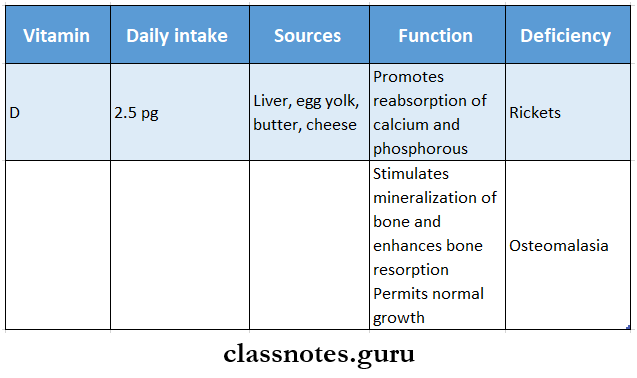
Adverse Effects: Hypervitaminosis D
Characterized by:
- Generalized decalcification of the bones
- Hypercalcaemia
- Hyperphosphataemia
- Weakness, drowsiness
- Nausea, abdominal pain
- Thirst
- Renal stones
- Hypertension
Uses:
- Prophylaxis
- Nutritional rickets and osteomalacia
- Vitamin D-resistant rickets
- Vitamin D-dependent rickets
- Senile osteoporosis
- Hypoparathyroidism
Pharmacology short notes
Miscellaneous Short Question And Answers
Question 1. Vitamin C / Ascorbic acid
Answer:
Sources:
- Citrus fruits- Gooseberry, guava
- Green vegetables
- Tomatoes and potatoes
Functions:
1. Role in collagen formation
- It acts as a coenzyme in the hydroxylation of proline and lysine
- These are required to convert procollagen to collagen
2. It is required for bone formation
3. Role in metabolism
- Iron metabolism
- It enhances iron absorption
- Helps in the formation of ferritin
- Helps in the mobilization of iron from ferritin
- Hemoglobin metabolism
- It is used to reconvert methemoglobin to hemoglobin
- Required for degradation of hemoglobin to bile pigments
- Tryptophan metabolism
- Essential for hydroxylation of. Tryptophan to hydroxytryptophan
- Tyrosine metabolism
- Required for oxidation of p-hydroxy phenyl py- rugate to homogenetic acid
- Folic acid metabolism
- Required for the formation of tetrahydrofolate, the active form of folic acid
4. Hormonal functions
- Peptides are derived from glycine
- Vitamin C is required for the hydroxylation of glycine
- It is required for the synthesis of steroids hormones
5. It is a strong antioxidant
6. It enhances the synthesis of immunoglobulin
7. Preventive functions
- It prevents the risk of
- Cataract
- Cancer
- Coronary heart diseases
Question 2. Vitamin B6
Answer:
Vitamin B6 is also known as pyridoxine
Functions:
- The Coenzyme of Pyridoxine, Pyridoxal phosphate, PLP, is attached to the delta amino group of lysine
- It participates in reactions like
- Transamination
- Decarboxylation
- Deamination
- Transsulfuration
- Synthetic functions
- Synthesis of niacin Coenzymes from tryptophan
- Synthesis of serine from glycine
- Glycogen phosphorylase contains PLP
- It is needed for the intestinal absorption of amino acids
- It prevents urinary stone formation
Uses:
- Prophylaxis in the treatment of pyridoxine deficiency,
- INH-induced peripheral neuritis and
- Convulsions in infants
Question 3. Vitamin B12
Answer:
- It is cyanocobalamine
Coenzyme Forms:
- 5′- Deoxyadenosyl cobalamin
- Methylcobalamin
Functions:
1. Synthesis of methionine from homocysteine
- Vitamin B12 is used as Methylcobalamin in this reaction
2. Isomerization of methylmalonic CoA to succinyl CoA
- It occurs in the presence of vitamin B12 Coenzyme, deoxyadenosine cobalamin
Dietary Requirements:
- Adults- 3 micrograms/day
- Children- 0.5-1.5 micrograms/day
- During pregnancy and lactation- 4 micrograms/day
Deficiency Symptoms:
- A deficiency of vitamin B12 leads to
1. Pernicious anemia
- Characterized by low hemoglobin levels, decreased number of erythrocytes, and neurological manifestations
2. Neuronal degeneration
3. Demyelination of the nervous system
Pharmacology solved papers
Question 4. The posterior pituitary extract is given by IV drip before delivery only
Answer:
- The posterior pituitary extract increases the force and the frequency of uterine contractions
- Induces labor
- Controls postpartum hemorrhage
- Thus it is given before delivery
Question 5. Tannic acid
Answer:
- Tannic acid is a vegetable astringent obtained from many plants
- It is found in tea, catechu, nutmeg, areca nut, etc
- They denature the proteins forming protein tannate
Uses:
- Bleeding gums- as glycerine
- Bleeding piles – as a tannic acid suppository
- Alkaloidal poisoning- Precipitates ingested alkaloids as tannates
Question 6. Clove oil
Answer:
- Clove, oil is a type of obtundent
- It diminishes sensitivity
Uses:
- To make excavation painless
Mechanism:
- It paralyzes the sensory nerves
- Causes initial irritation followed by numbness
Disadvantage:
- It may stain the dentin yellow
Question 7. Counter irritants
Answer:
- Certain irritants produce a remote effect that tends to relieve pain and inflammation in deeper organs
- These are called counterirritants
- When counter-irritants are applied to the area of skin supplied by nerves from the same segment as the deeper organs from which impulses are produced, the cutaneous impulses obscure the deeper situations
- They are generally massaged to relieve
- Headache
- Muscular pain
- Joint pain
- Pleural or peritoneal pain
- Colics
- Drugs commonly used are
- Turpentine oil
- Clove oil
- Eucalyptus oil
- Mustard seeds
- Capsicum
- Methyl salicylate
- Alcohol
Examples: Vicks vaporub, amruthanjan, iodex.
Important pharmacology questions
Question 8. Name four chelating agents.
Answer:
